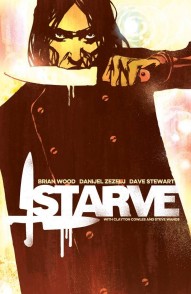
In typical Wood fashion, the series isn't as straightforward as the solicits would have you believe. The pages are full of social commentary yet grounded in personal struggle, a Wood staple since his college days and first published work Channel Zero in 1996. He wears his politics on his sleeve, but it never feels heavy handed. The backdrop of social inequality, modern journalism, and reality TV gone wrong never feel crammed in, and elevate the series from mere comics to something greater. The pacing is quick where it needs to be, but there are plenty of slower moments of character development. Gavin's daughter Angie is the heart of the series, reigning him in when he gets too antagonistic, and acting as a counter-balance to his greedy, spiteful ex.
Daniel Zezelj is the perfect artist to bring this story to life alongside Dave Stewart's always masterful use of color. Zezelj's lines have much of the same sensibilities of Wood's own art, giving the pages an almost wheat-pasted, graffitied look that fits the tone of the story. Chef Cruikshank has a bit of an anarchistic bent to his character, and this is personified in the style of the book. The book begins with a highly claustrophobic style befitting Gavin's surroundings, but opens up as the story develops. His panels are dense and full of highly detailed backgrounds giving this world a lived-in appearance, especially in its architecture.
Stewart is one of the best colorists around, with an uncanny ability to adapt his style to cater to whichever artist he happens to be working with. With Starve he utilizes a muted palette and a painterly style that counteracts and elevates Zezelj's stark, jet-black linework.
Overall, Starve is a compelling, confrontational, and unique read full of three-dimensional characters, social commentary, and heartfelt human emotion elevating an interesting concept to the fascinating.